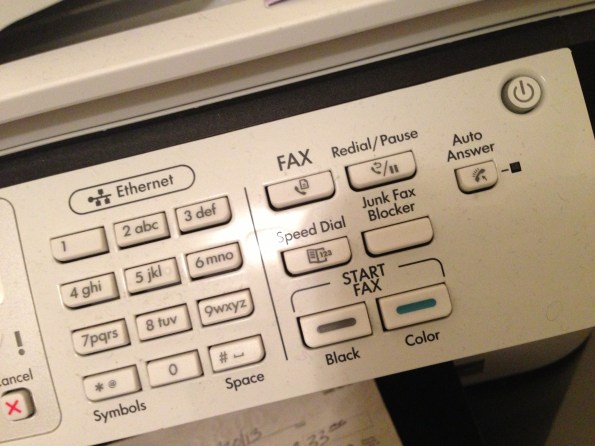Archive
Send #Faxes via #API using C# @Twilio

Faxes are still an old technology, and to be honest, I fail to understand how some companies still require them for certain authenticated (signed) documents. There are numerous services online that provide paid-for faxes, like sendfaxes.co.uk
However, I saw that Twilio offers a FAX API, so if you wanted to add the functionality to your C# application, then here’s some sample code;
const string username = “xxxxx”;
const string password = “zzzzzz”;var strUrl = “https://fax.twilio.com/v1/Faxes”;
strUrl = string.Format(strUrl, username);
var wc = new WebClient();
wc.Headers[“Content-Type”] = “application/x-www-form-urlencoded”;
var credentials = Convert.ToBase64String(Encoding.ASCII.GetBytes(username + “:” + password));
wc.Headers[HttpRequestHeader.Authorization] = string.Format(
“Basic {0}”, credentials);var strResponse = wc.UploadString(strUrl, “To=%2B” + strToNumber +
“&From=%2B” + strFromNumber +
“&MediaUrl=” + strFax);
I tested this against FaxBurner, in order to get a temporary FAX number, and after about 2 minutes the fax arrived.
The Fax I sent was this: http://www.xmlpdf.com/manualfiles/hello-world.pdf – and it arrived in a similar format, but with the grey turned into a pattern of dots, since Faxes are monochrome. (as below)

It is worth noting that during the 2 minutes when the FAX was being sent, it was possible to poll on Twilio for a status update, by calling the url with authentication, and with the SID returned in the JSON – https://fax.twilio.com/v1/Faxes\/{sid}
The status property of the JSON moved from “queued” to “sending” then finally “delivered” – i.e.
{
“media_sid”: “ME88a43ed8bdf1ddc9dbce3914ceeee7f3”,
“status”: “delivered”,
“direction”: “outbound”,
“from”: “+16193332636”,
“date_updated”: “2017-05-25T11:09:29Z”,
“price”: “-0.035”,
“account_sid”: “AC84d144631d43d12966be8c03e2c6a640”,
“to”: “+18668158879”,
“date_created”: “2017-05-25T11:04:20Z”,
“url”: “https:\/\/fax.twilio.com\/v1\/Faxes\/FXa6503014cfdc71509b9bf9f02cc7976a”,
“sid”: “FXa6503014cfdc71509b9bf9f02cc7976a”,
“duration”: 286,
“num_pages”: 1,
“quality”: “fine”,
“price_unit”: “USD”,
“api_version”: “v1”,
“media_url”: “https:\/\/media.twiliocdn.com\/fax\/AC84d144631d43d12966be8c03e2c6a640\/e5225a49644c2edd383baa803b4db3a2061c7301cdea8b2b600568b5adfa16b326c345334b0b0a8100a5fc608fa58ab330b365830df5308a84a2ec78bc924137?x-amz-security-token=FQoDYXdzEOr%2F%2F%2F%2F%2F%2F%2F%2F%2F%2FwEaDHhP4wXa%2F%2BYky2StOCK3A2efy0tyDbg1GlWUU58EVMiK8arQIwL8MuNF0RkNNjeQ7OhI5rEJ8Jt3Gm59qYbBTpS7Ay9RmVNkePDTc19I96r16IZQzBR3G1zlZ4rhZE%2BORofirA3qv2lopLvokhyHj8UNtXMZ73pvWaJ32fcXmvbpkbgc50O8Mjuah84D5pc2w1nI0WlhCQB5btB9bvL5gbavI2ZbHKodUpgA%2FrQilGtEn7fXeO4S4J07Vp5o4LRSzFH7K3HWfgRdZxo3GYxKZqm6WCiR8qk2JQubBNbqJByY4Wb6R4a39OykpkZHPcr6gllDFqrF0fV%2B4%2FyWeukGfvEaEN332LZGJ%2BZj6hLyAWrG5vNtDZNvDr%2BoSwssnXhiu7wQn7syqs6WVCxy5KnmRi6c3PNvsAgAL6RkI%2F2alN7hxexVMxN%2BhnDmuT6c2Wb%2FtEFXJwIxOd1vMWgVIVDX%2FORrxyugIpcyNyDLghRm8cMtCKeED12TpGIdpbHQLPZTBpObPyRluJ4ZYOQkcGfRoFrJxdBPayRawTlLOBaKfY23yMzwWkH9cQKHlvXTGDy6MBrjb3wEVwHu5C4B1WndHIpSfKXPaAMotL%2BayQU%3D&AWSAccessKeyId=ASIAJH4JX2XKGVNEIEFA&Expires=1495717784&Signature=erQay6zd%2BzjBjYGxtf5BoHIiJMo%3D”,
“links”: {
“media”: “https:\/\/fax.twilio.com\/v1\/Faxes\/FXa6503014cfdc71509b9bf9f02cc7976a\/Media”
}
}
#REST based #API open for feedback
Beta REST API reference
Overview
The REST Beta API is a JSON based API that accepts basic HTTP authentication for user identification. This API is still in BETA, and is therefore open for discussion and feedback from our users, but also may be changed without warning. If you would like to use this API in production, please let us know.
The format of the REST URL is as follows:
| https://www.regcheck.org.uk/api/json.aspx/{Method}/{Parameter1}/{Parameter2} |
Where {Method} is one of the following options;
CarSpecifications
Get static data based on a make, model and year of a car
Check
Get details for a vehicle in the UK
CheckAustralia
Get details for a vehicle in Australia
CheckBelgium
Get details for a vehicle in Belgium
CheckCroatia
Get details for a vehicle in Croatia
CheckCzechRepublic
Get details for a vehicle in the Czech Republic
CheckDenmark
Get details for a vehicle in Denmark
CheckEstonia
Get details for a vehicle in Estonia
CheckFinland
Get details for a vehicle in Finland
CheckFrance
Get details for a vehicle in France
CheckHungary
Get details for a vehicle in Hungary
CheckIndia
Get details for a vehicle in India
CheckIreland
Get details for a vehicle in Ireland
CheckItaly
Get details for a vehicle in Italy
CheckMotorBikeUK
Get details for a motorbike in the UK
CheckNetherlands
Get details for a vehicle in the Netherlands
CheckNewZealand
Get details for a vehicle in New Zealand
CheckNorway
Get details for a vehicle in Norway
CheckPakistan
Get details for a vehicle in Pakistan
CheckPortugal
Get details for a vehicle in Portugal
CheckRussia
Get details for a vehicle in Russia
CheckSlovakia
Get details for a vehicle in Slovakia
CheckSouthAfrica
Get details for a vehicle in South Africa
CheckSpain
Get details for a vehicle in Spain
CheckSriLanka
Get details for a vehicle in Sri Lanka
CheckSweden
Get details for a vehicle in Sweden
CheckUAE
Get details for a vehicle in United Arab Emirates
CheckUSA
Get details for a vehicle in the USA
UKMOT
Get MOT (Vehicle test) data for a car in England, Scotland or Wales
VinCheck
Get details for a vehicle based on its VIN number
WheelSize
Get Wheel size data based on a make, model and year of a car
So a sample request for a search on plate YYO7XHH in the UK would be:
| https://www.regcheck.org.uk/api/json.aspx/Check/YYO7XHH |
Which would return the following JSON
| { “ABICode”: “39049602”, “Description”: “2007 Peugeot 307 X-line, 1360CC Petrol, 5DR, Manual”, “RegistrationYear”: “2007”, “CarMake”: { “CurrentTextValue”: “Peugeot” }, “CarModel”: { “CurrentTextValue”: “307” }, “EngineSize”: { “CurrentTextValue”: “1360CC” }, “FuelType”: { “CurrentTextValue”: “Petrol” }, “MakeDescription”: “Peugeot”, “ModelDescription”: “307”, “Immobiliser”: { “CurrentTextValue”: “” }, “NumberOfSeats”: { “CurrentTextValue”: 5 }, “IndicativeValue”: { “CurrentTextValue”: “” }, “DriverSide”: { “CurrentTextValue”: “RHD” }, “Transmission”: { “CurrentTextValue”: “Manual” }, “NumberOfDoors”: { “CurrentTextValue”: “5” }, “ImageUrl”: “http:\/\/www.regcheck.org.uk\/image.aspx\/@UGV1Z2VvdCAzMDc=”, “VehicleInsuranceGroup”: “04” } |
Exceptions:
Certain REST API calls require more than one parameter, and these are as follows;
CarSpecifications
This is called in the format Make / Model / Year, for example;
https://www.regcheck.org.uk/api/json.aspx/CarSpecifications/Honda/Civic/2014
CheckAustralia
This is called in the format Registration Number / State, for example:
https://www.regcheck.org.uk/api/json.aspx/CheckAustralia/CEC36T/NSW
CheckUSA
This is called in the format Registration Number / State, for example:
https://www.regcheck.org.uk/api/json.aspx/CheckUSA/jxv7422/pa
CheckPakistan
This is called in the format Registration Number / State / District, for example:
https://www.regcheck.org.uk/api/json.aspx/CheckPakistan/STR%206006/PB/Pathankot
UKMOT
This is called in the format Registration Number / Make, for example:
https://www.regcheck.org.uk/api/json.aspx/UKMOT/DE02VOV/PEUGEOT
VinCheck
This is called with a VIN number instead of a registration number. for example;
https://www.regcheck.org.uk/api/json.aspx/VinCheck/5XYZT3LB9FG259411
WheelSize
This is called in the format Make / Model / Year, for example;
https://www.regcheck.org.uk/api/json.aspx/WheelSize/Ford/Focus/2014
Enter card details using camera @cardio #cordova #phonegap

Entering a 16 digit number into an app is error prone, and can frustrate a user right at the point of purchase. There is a really cool Cordova / Phonegap plugin that allows you scan a credit card using the camera, so you can input it into the page, without the user having to type.
Although the plugin is developed by paypal, you can use it with other PSPs, like stripe, – and since the processing is done on-device, there is no transmission of sensitive data.
You add the plugin to your project using:
cordova plugin add https://github.com/card-io/card.io-Cordova-Plugin
Then you call it in Javascript with code such as;
CardIO.scan({
“requireExpiry”: true,
“requireCVV”: true,
“requirePostalCode”: false,
“restrictPostalCodeToNumericOnly”: true
},
function(response){$scope.form.CardNumber = parseInt(response[“cardNumber”]);
var dtExpiry = new Date(response[“expiryYear”], response[“expiryMonth”], 1);
$scope.form.CardExpiry = dtExpiry;
$scope.form.CardCvv = parseInt(response[“cvv”]);
$scope.$apply();
},
function(){
sweetAlert(“Oops…”, “Your card scan has failed”, “error”);
}
);
Adding a #URL to #Google just got easier #SEO

Step 1 of any SEO exercise is to add the URL to google; now you just can just search in the address bar, add URL to Google, and just add it below, without leaving the Google search.
Sure, Google will find your new website in a few days as long as you are doing “some” sort of off-page SEO activity; but this is the fast-track.
If you are planning to target Chinese users you’ll need to submit to Baidu also; and a couple of other minor search engines in China – for this I’d recommend using a service on fiverr to do this, since it is difficult to follow the procedure without knowing chinese.
Similarly, if you want to target the Russian market you will need to submit to Yandex. This has an english version, and you can get by without knowing any russian.
Just for context, I was relaunching two indian sites; http://india.appaio.com and http://india.listofcardealers.info
Send #Email with Attachments from #Javascript

We’ve made a few updates to SMTPJS.com –
- We now allow attachments, so you can get your Javascript to include an attachment with the email;
use sendWithAttachment:
Email.sendWithAttachment( "from@you.com", "to@them.com", "Subject", "Body", "host.yourisp.com", "username", "password", "http://url-where-your-attachment-file-is-stored"); - We now assume your SMTP server supports SSL. If it doesn’t … it should! 🙂
- We’ve secured all client-server communications using HTTPS for added security.
- We now use CORS for client-server communication, which currently has 95.33 % browser coverage.